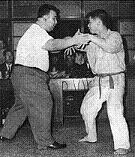|
Tang Shou Dao
-("Chinese Hand Way") founded in the 1950s and 1960s by Hung I-Hsiang
(洪懿祥, Hanyu Pinyin: Hong Yixiang), a well-known Taiwanese internal martial
artist. The system was further modified by Hung's student, Hsu Hung-Chi
(許鴻基, Hanyu Pinyin: Xu Hongji) under the name Shen Long Tang Shou Tao
(神龙唐手道; lit. "Spirit Dragon Chinese Hand Way"). |
 |
|
A practical,
step-by-step, systematic approach to learning internal martial arts and
developing highly refined levels of skill. It incorporates elements of all
three of the major Chinese internal arts (xingyiquan, baguazhang, and
taijiquan) as well as Shaolin kung fu and qigong. However, the emphasis of
this system is on xingyi and bagua. Although the system itself was formed
and founded by Hung I-Hsiang during the 1950s and 1960s, the roots of using
the commonalities of bagua and xingyi in practice and application can easily
be traced back through Hung's teacher Chang Chun-Feng (張俊峰) to his teachers,
Li Cunyi (李存義) and Gao Yisheng (高義盛).
When Hung I-Hsiang took a trip to Japan, he was very impressed with the way
martial arts instruction was organized there. He liked the uniforms, the
belt system, and the systematic approach to training. Subsequently, he
adopted many of the Japanese style martial arts school characteristics when
he opened his own school. The students had belt ranks, wore Japanese style
uniforms, and Hung devised a more systematic approach to martial arts
instruction than what was typical of most Chinese style schools.
Hung felt that before a student was ready to learn xingyiquan or any of the
other internal arts, he first had to acquire body strength and basic martial
arts skill. The beginning student in Hung's Tang Shou Tao system executes
many basic exercises which develop body strength, flexibility, coordination,
and balance at the rudimentary level. Many of these exercises were taken
from Japanese styles such as Judo. The basic curriculum also included simple
forms which Hung had put together by combining Shaolin with basic xingyi and
bagua movements and techniques. Hung wanted students to have a basic
understanding of blocking, kicking, punching, and throwing before they began
to study the more refined internal arts. |













